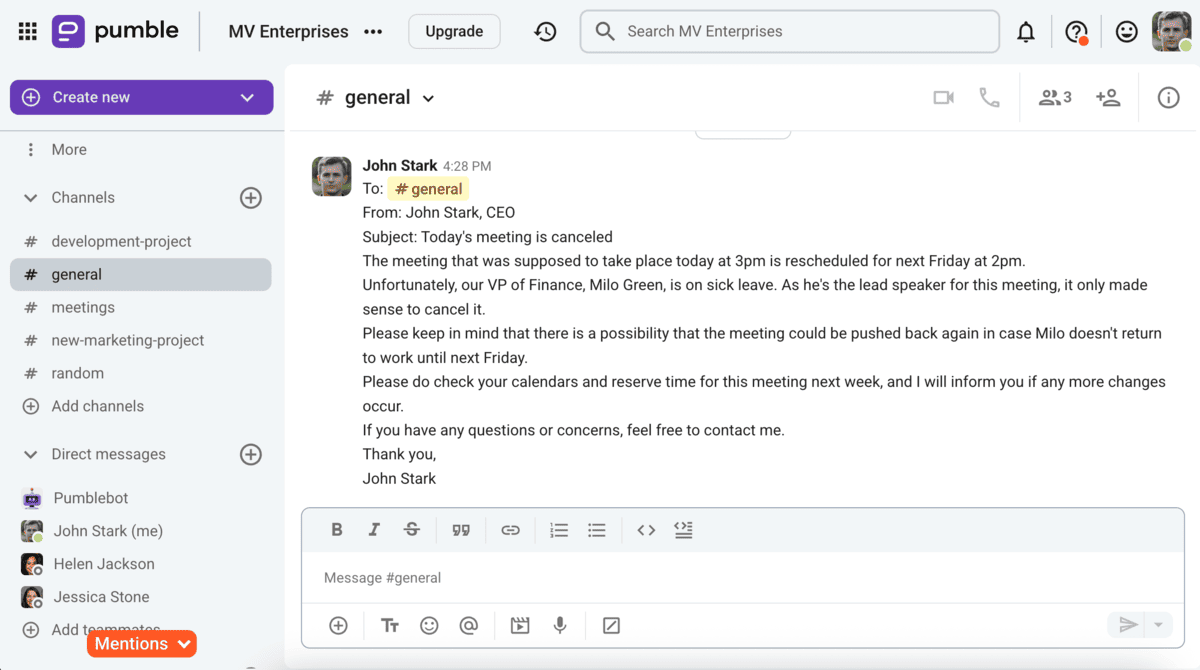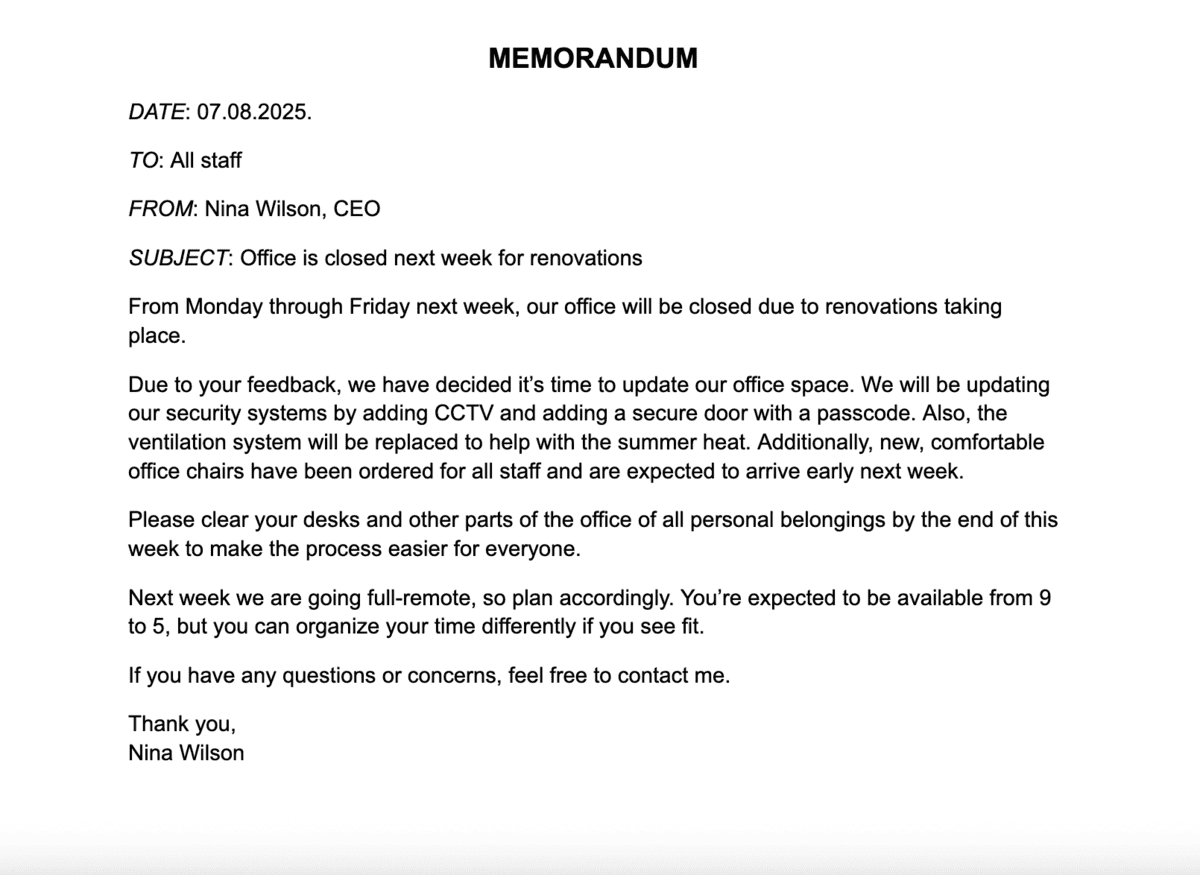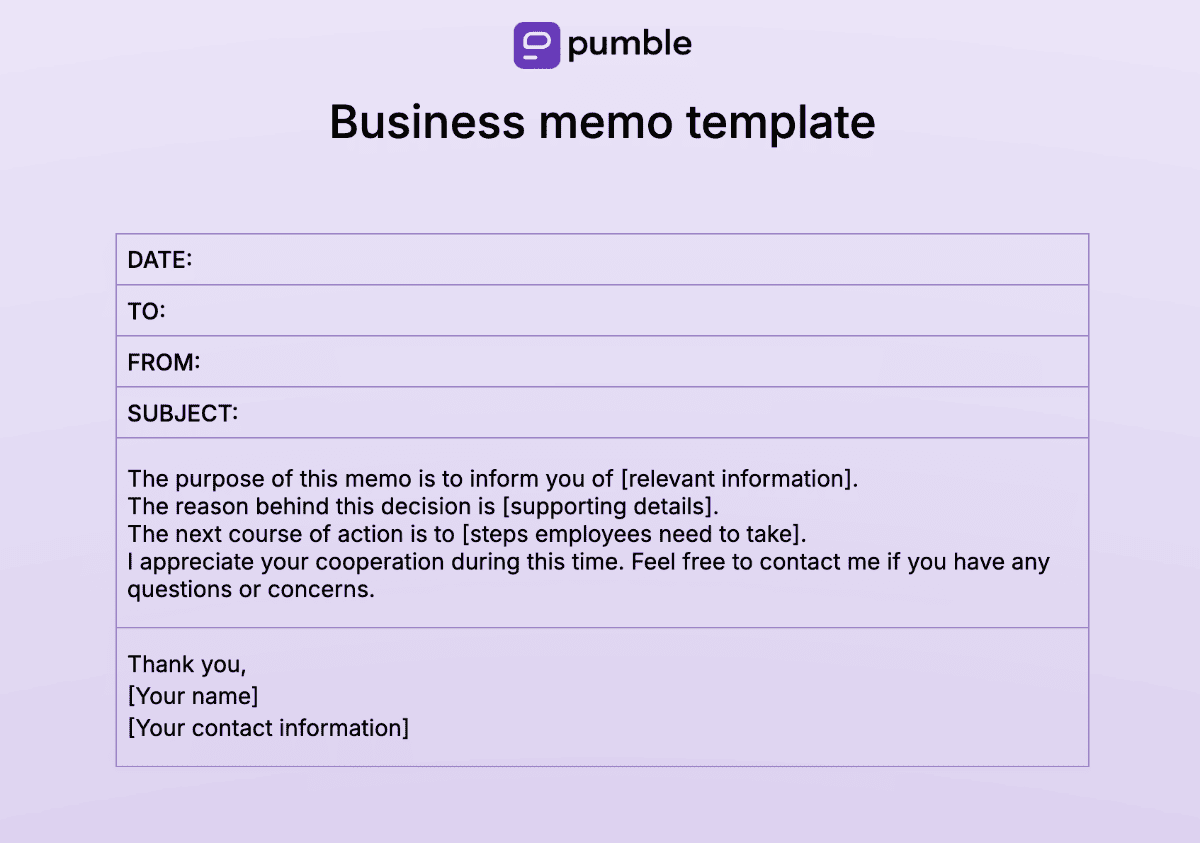Need to update your team but not sure how to write a business memo?
You’re in the right place.
Even though emails and communication apps are taking over business communication, memos are still one of the clearest, most professional ways to share important updates.
In this post, you’ll learn:
- What a business memo is,
- The key parts of a memo,
- How to use the right memo writing format, and
- Tips on how to write a business memo that gets results.
We’ll also provide some examples of good business memos.
Let’s start.

Table of Contents
What is a business memo?
A business memo is an internal document used to quickly share key updates across a company. Think of it as a streamlined press release — written for your team, not the public.
While less formal than business letters, memos still need to be professional and respectful. The goal is to inform, not debate or seek approval.
Common uses for a business memo include:
- Workforce changes (e.g., employee departures or new hires),
- Announcements about meetings or events, or
- Operational updates (e.g., time-off policies or workflow shifts).
In short, a corporate memo communicates decisions that have already been made and tells employees what to expect or do next. It’s not a space for discussion — it’s about clarity and direction.
Stay connected with your team via Pumble
What should a business memo include?
The key to a good business memo is being clear and concise. A well-structured memo format makes it easier to read and understand the information.
To follow the proper business memo format, include these essential parts of a memo:
- Header,
- Main point,
- Supporting details,
- Call to action, and
- Closing statement.
Let’s break down each of these elements in more detail.
Element #1: Header
The header is the first element of your memo. It contains the necessary information about the sender, as well as the subject of the memo.
Here’s what a header of a business memo typically looks like:
- To — List the recipient’s names and job titles or the name of the department you’re sending the memo to.
- From — List your name and job title.
- Date — Write the date when you’re sending the memo.
- Subject — Explain the reason for the memo briefly.
Element #2: Main point
Right after the header comes your main point.
There is no need for a greeting of any sort in a business memo, so get straight to the point.
Make sure to explain the main subject in the first one or two sentences.
For example, if you’re writing a memo about a day off that everyone is having next week, the first sentence should sound something like this:
“The purpose of this memo is to inform you that next Monday, [include specific date], will be a day off for all staff.”
This is important because it makes the reader aware of the point right away and makes it easier to understand and act upon if needed.
This is the most important element of the business memo, so make it clear and informative.
Element #3: Supporting details
After presenting the main point of the memo, you can provide details and explanations that support your main point.
In the example of a company-wide day off, here is where you’re supposed to go into more detail about it. Perhaps it’s a public holiday or a mandatory day off for a religious holiday. State the reason behind the decision in this paragraph.
Also, think about what kind of questions your coworkers might have, and answer those in this part of the memo. Once again, you shouldn’t go too much into detail, but make it informative enough so the readers can understand why the changes have been made.
Furthermore, you should inform the reader of the timeline of events:
- What changes have already been made,
- When the new changes will take place, and
- What the planned changes for the future are.
After this part of the memo, the reader should be well aware of the changes and why they happened.
Element #4: Call to action
Next up is a call to action (CTA).
This part is optional, as it’s not always necessary for employees to do something after getting a memo. Sometimes, a memo is just to inform them of something.
However, sometimes employees will be expected to take certain steps after reading the memo.
Here’s some advice about CTAs from Cynthia Davis, a founder and CEO:

“My best advice on writing an effective business memo is to include a clear call to action so that people know what to do after reading it.
This ensures that the memo is not just a passive transmission of information, but a proactive step toward achieving the desired outcome. Without a call to action, the information within the memo may be left unheeded, or employees may not know what specific steps to take in response.”
Therefore, make sure to instruct employees on the next steps they need to take. Consider employees of all levels, and instruct them accordingly.
Make sure to clearly state any deadlines or specific rules that need to be followed.
If no action is needed, make sure to include that information as well, to avoid confusion.
Therefore, if any action is needed on behalf of the employees, make it clear and instruct your staff on what they need to do.
Hold follow-up meetings with Pumble
Element #5: Closing statement
To finish off your business memo, include a closing statement.
Refer back to the main point and reinforce it. This is also the time when you instruct the reader to contact you if they have any questions.
At the very end of your memo, include a footer.
This can just be as simple as a “thank you” followed by your name.
You can also add your contact information, such as your email address. This way, employees can reach you if they need clarification on anything related to your business memo.
If applicable to your business and industry, you can add a phone number for contact information.
In any case, include a footer to mark the end of your memo — don’t just cut it off.
Example of an effective business memo
To help you better visualize what a business memo is supposed to look like, let’s look at a couple of examples.
For the first example, we have a more informal way of delivering a business memo — through a business messaging app.
Here’s how John Stark informed his team about a meeting cancelation in Pumble, a business messaging app:

If you want a more formal way to communicate, sending out an email with an attached document can be a good option.
Here’s an example of a business memo sent through email in the form of a PDF document:

Business memo templates
A great way to write consistently good business memos is to have a template ready.
This way, you can have a universal style and structure of a memo. This will make it easier for the writer of the memo, as well as the reader.
We have designed a business memo template that you can download and use.

🔽 Download our free business memo template here
You just need to change the relevant information to fit whatever you’re trying to say, but the structure can remain the same. That way, you don’t have to rack your brain every time you need a business memo.
How to write an effective business memo?
Now that you have the necessary information about what a business memo should look like, let’s focus on making it effective.
Always keep in mind that a memo should be:
- Clear,
- Direct, and
- Easy to read.
Let’s go over some tips on how to write an effective business memo.
Tip #1: Know your audience
Before you write a business memo, think about who will read it.
A memo to your direct team will sound different than one addressed to the entire company or upper management. While your tone should always be professional, the level of formality and detail should match the audience.
According to Andrew Chen, a CSO and Managing Partner, the tone and language you use in your business memo is crucial:d:

“The purpose of the memo should dictate its tone. Memos are typically used for internal communication, so it’s best to keep the tone friendly, yet professional. Ensure that the memo does not contain any personal bias and remains objective. Also, keep in mind that business memos often relate to company procedures and policies and can have legal standing.”
In multicultural workplaces, make sure your memo is written in clear, accessible language.
Connect across time zones with Pumble
Tip #2: State the subject right away
In both the header and body of your business memo, be specific and direct.
Your memo format should always include a clear subject line that tells the reader exactly what the memo is about — so, avoid vague headlines.
For example, let’s say you’re sending out a memo about a rescheduled meeting. The subject line should say “Today’s meeting rescheduled for tomorrow”, rather than “News about the meeting”.
That way, everyone who gets the memo will understand what it’s about, even without going through it.
Apply the same logic to your opening paragraph. The first sentence or two should clearly state the purpose of the memo. Don’t bury the lead — your reader should know the main point immediately.
This clarity is one of the defining parts of a memo and a hallmark of professional business memos.
💡 Pumble Pro Tip
Direct communication in the workplace is an important skill to have. To learn more about direct communication and how you can implement it in your workplace, check out our blog post:
Tip #3: Be concise and precise
A business memo is, by definition, a short piece of writing.
Therefore, the most important tip to keep in mind while writing is to be as concise as you can.
This shouldn’t obstruct you from delivering the information correctly, but rather make you deliver it directly and without unnecessary details.
Use short paragraphs, plain language, and avoid fluff.
Having a clear goal in mind when writing a business memo is essential, according to Andrew Tsionas, a Marketing leader:

“Start with a clear goal in mind. What do you want to achieve by writing this memo? What is the purpose of it? If you can answer these questions clearly, you will be able to focus your writing and avoid wasting time on tangents or irrelevant information.”
Furthermore, a business memo isn’t a place to start conversations about many different topics.
You should address a single issue or inform your employees of one change at a time.
Write separate memos for separate issues and keep your memos short.
Schedule a Pumble meeting for discussions
Tip #4: Maintain a professional tone
A business memo is an internal document. However, you still need to remain professional and polite when writing one.
Always use appropriate language and avoid using technical jargon if you’re writing to people from a different department — they may not understand it.
Tsionas also highlights the importance of professionalism and plain language when writing memos:

“Keep your tone professional. This isn’t the time for flowery language or fancy prose — stick to plain English that is easy to understand. If your memo requires additional information or clarification, include a brief note at the end of the document asking for feedback or further explanation.”
Even with members of your team, a level of professionalism should always be upheld. Write your memos with this in mind.
Tip #5: Provide a summary if the memo is long
By now, you should know that memos should be short. However, that isn’t always applicable. Sometimes memos can go on for more than a page.
In that situation, make sure to provide a summary of the most important points.
Keynote Speaker and VP, Logan Mallory, agrees that summaries are sometimes necessary:

“When writing a business memo, it’s best to start with a brief summary to provide readers with a clear understanding of the memo’s purpose and main points. By providing a summary upfront, readers can quickly understand the context of the memo and determine whether they need to read it further.”
You can do this by carefully writing your first paragraph as a summary of the whole memo.
Make sure to include:
- The main point of memo,
- The most important facts behind the decision, and
- A basic overview of the rest of the memo.
If you write a good summary paragraph, it will be much easier to know what’s important right away.
Also, a summary paragraph will be useful if anyone needs to look back on the memo in the future.
Tip #6: Pay attention to formatting
Be mindful of formatting your business memos the right way.
To follow best memo writing format practices:
- Use clear headers and bullet points,
- Stick to standard fonts and sizes,
- Keep paragraphs focused on one idea, and
- Break the memo into clean, logical sections.
💡 Pumble Pro Tip
If you want to learn more about formatting messages at work, and why it’s important, check out our blog post:
Tip #7: Review before sending
Finally, review your memo carefully before you send it.
Proofread for grammar, typos, and clarity. A sloppy business memorandum can hurt your credibility, even if the content is solid.
If it’s a high-stakes memo, ask a colleague to review it.
Make sure it aligns with the standard memo format and clearly communicates your message.
Write, share, and discuss your business memos with Pumble
Clear, effective communication is the foundation of a productive workplace.
With the right tools, you can create a culture of transparency, clarity, and accountability.
Pumble is an all-in-one communication platform built to simplify workplace messaging and help you share important information, like business memos, in a structured, accessible way.

Use Pumble’s features to support seamless communication at every level:
- Video calls — Discuss memo updates or hold quick check-ins face-to-face.
- Direct messages — Clarify memo details and keep side conversations organized.
- Channels — Share memos with entire departments or teams, and pin key updates.
- File sharing — Store and distribute memo examples, templates, and documents.
Upgrade how your team communicates!








